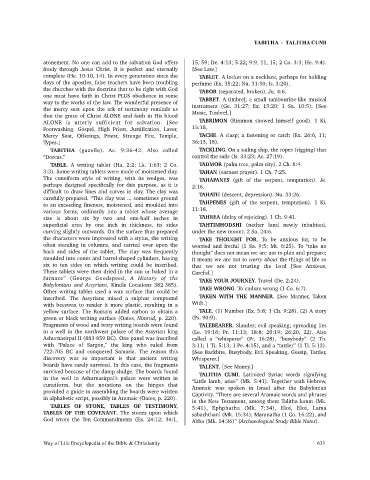Page 631 - Way of Life Encyclopedia of the Bible Christianity. Based on the King James Bible
P. 631
TABITHA - TALITHA CUMI
atonement. No one can add to the salvation God offers 15, 59; De. 4:13; 5:22; 9:9, 11, 15; 2 Co. 3:3; He. 9:4).
freely through Jesus Christ. It is perfect and eternally [See Law.]
complete (He. 10:10, 14). In every generation since the TABLET. A locket on a necklace, perhaps for holding
days of the apostles, false teachers have been troubling perfume (Ex. 35:22; Nu. 31:50; Is. 3:20).
the churches with the doctrine that to be right with God TABOR (separated, broken). Ju. 4:6.
one must have faith in Christ PLUS obedience in some
way to the works of the law. The wonderful presence of TABRET. A timbrel; a small tambourine-like musical
the mercy seat upon the ark of testimony reminds us instrument (Ge. 31:27; Ex. 15:20; 1 Sa. 10:5). [See
that the grace of Christ ALONE and faith in His blood Music, Timbrel.]
ALONE is utterly sufficient for salvation. [See TABRIMON (Rimmon showed himself good). 1 Ki.
Footwashing, Gospel, High Priest, Justification, Laver, 15:18.
Mercy Seat, Offerings, Priest, Strange Fire, Temple, TACHE. A clasp; a fastening or catch (Ex. 26:6, 11;
Types.] 36:13, 18).
TABITHA (gazelle). Ac. 9:36-42. Also called TACKLING. On a sailing ship, the ropes (rigging) that
“Dorcas.” control the sails (Is. 33:23; Ac. 27:19).
TABLE. A writing tablet (Ha. 2:2; Lk. 1:63; 2 Co. TADMOR (palm tree, palm city). 2 Ch. 8:4.
3:3). Some writing tablets were made of moistened clay. TAHAN (earnest prayer). 1 Ch. 7:25.
The cuneiform style of writing, with its wedges, was TAHAPANES (gift of the serpent, temptation). Je.
perhaps designed specifically for this purpose, as it is 2:16.
difficult to draw lines and curves in clay. The clay was TAHATH (descent, depression). Nu. 33:26.
carefully prepared. “This clay was ... sometimes ground
to an exceeding fineness, moistened, and moulded into TAHPENES (gift of the serpent, temptation). 1 Ki.
various forms, ordinarily into a tablet whose average 11:18.
size is about six by two and one-half inches in TAHREA (delay of rejoicing). 1 Ch. 9:41.
superficial area by one inch in thickness, its sides TAHTIMHODSHI (nether land newly inhabited,
curving slightly outwards. On the surface thus prepared under the new moon). 2 Sa. 24:6.
the characters were impressed with a stylus, the writing TAKE THOUGHT FOR. To be anxious for, to be
often standing in columns, and carried over upon the worried and fretful (1 Sa. 9:5; Mt. 6:25). To “take no
back and sides of the tablet. The clay was frequently thought” does not mean we are not to plan and prepare;
moulded into cones and barrel-shaped cylinders, having it means we are not to worry about the things of life so
six to ten sides on which writing could be inscribed. that we are not trusting the Lord [See Anxious,
These tablets were then dried in the sun or baked in a Careful.]
furnace” (George Goodspeed, A History of the TAKE YOUR JOURNEY. Travel (De. 2:24).
Babylonians and Assyrians, Kindle Locations 382-385).
Other writing tables used a wax surface that could be TAKE WRONG. To endure wrong (1 Co. 6:7).
inscribed. The Assyrians mixed a sulphur compound TAKEN WITH THE MANNER. [See Manner, Taken
with beeswax to render it more plastic, resulting in a With.]
yellow surface. The Romans added carbon to obtain a TALE. (1) Number (Ex. 5:8; 1 Ch. 9:28). (2) A story
green or black writing surface (Oates, Nimrud, p. 220). (Ps. 90:9).
Fragments of wood and ivory writing boards were found TALEBEARER. Slander; evil speaking; spreading lies
in a well in the northwest palace of the Assyrian king (Le. 19:16; Pr. 11:13; 18:8; 20:19; 26:20, 22). Also
Ashurnasirpal II (883-859 BC). One panel was inscribed called a “whisperer” (Pr. 16:28), “busybody” (2 Th.
with “Palace of Sargon,” the king who ruled from 3:11; 1 Ti. 5:13; 1 Pe. 4:15), and a “tattler” (1 Ti. 5:13).
722-705 BC and conquered Samaria. The reason this [See Backbite, Busybody, Evil Speaking, Gossip, Tattler,
discovery was so important is that ancient writing Whisperer.]
boards have rarely survived. In this case, the fragments TALENT. [See Money.]
survived because of the damp sludge. The boards found TALITHA CUMI. Latinized Syriac words signifying
in the well in Ashurnasirpal’s palace were written in “Little lamb, arise” (Mk. 5:41). Together with Hebrew,
cuneiform, but the notations on the hinges that Aramaic was spoken in Israel after the Babylonian
provided a guide to assembling the boards were written Captivity. “There are several Aramaic words and phrases
in alphabetic script, possibly in Aramaic (Oates, p. 220). in the New Testament, among them Talitha koum (Mk.
TABLES OF STONE, TABLES OF TESTIMONY, 5:41), Ephphatha (Mk. 7:34), Eloi, Eloi, Lama
TABLES OF THE COVENANT. The stones upon which sabachthani (Mk. 15:34), Maranatha (1 Co. 16:22), and
God wrote the Ten Commandments (Ex. 24:12; 34:1, Abba (Mk. 14:36)” (Archaeological Study Bible Notes).
Way of Life Encyclopedia of the Bible & Christianity 631

